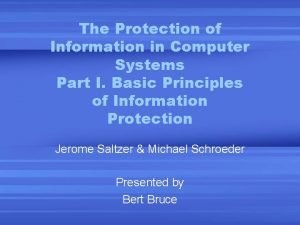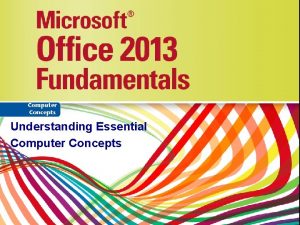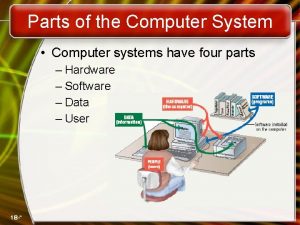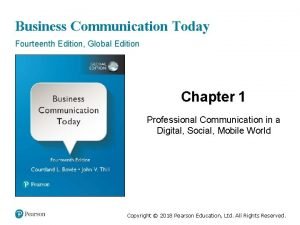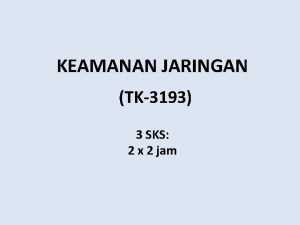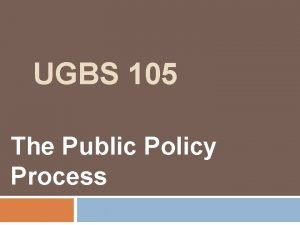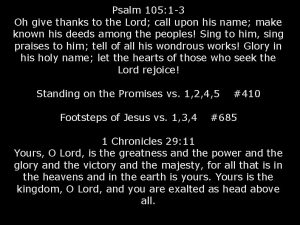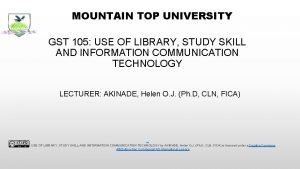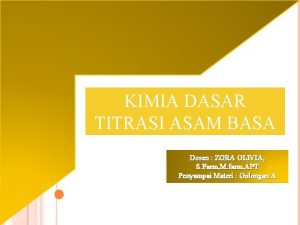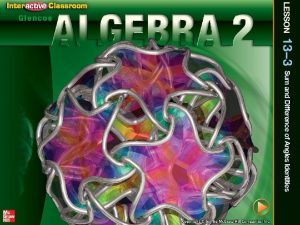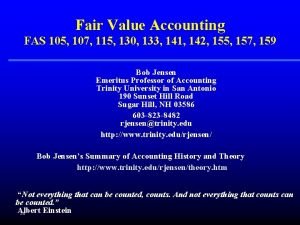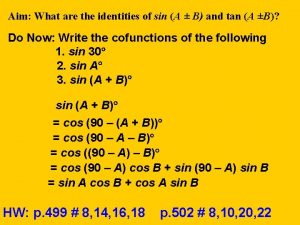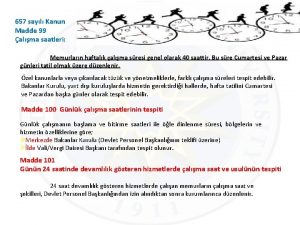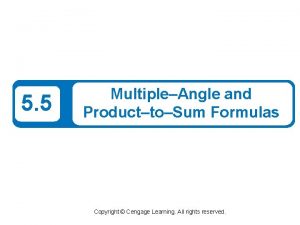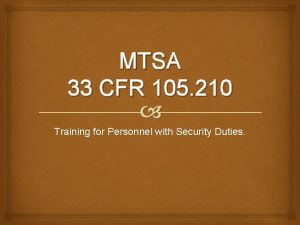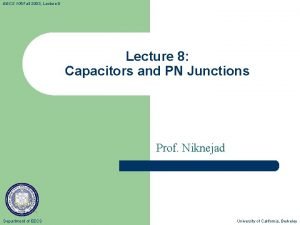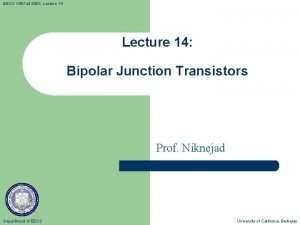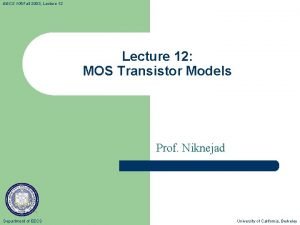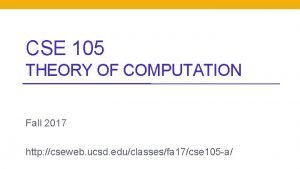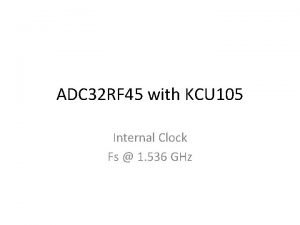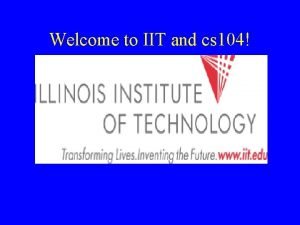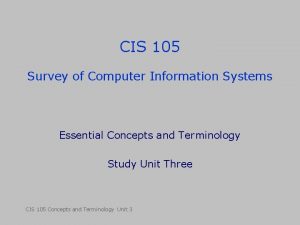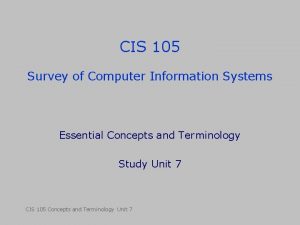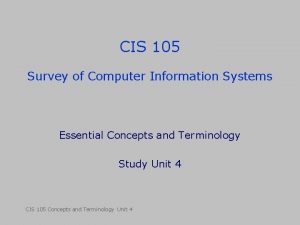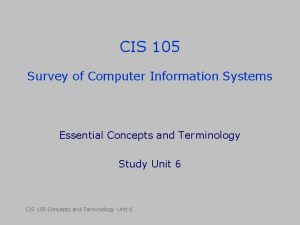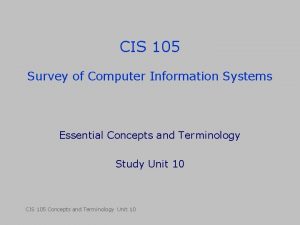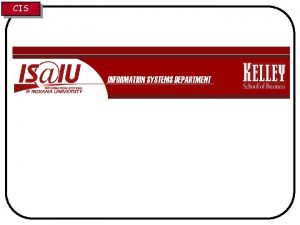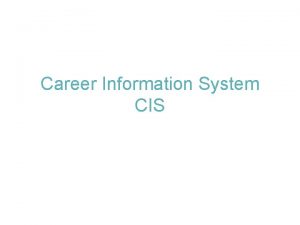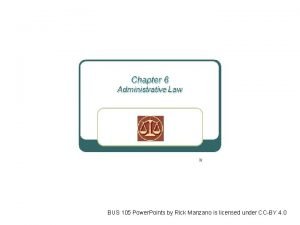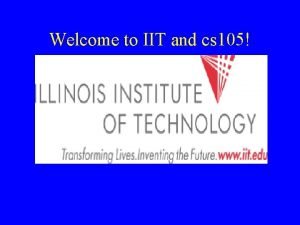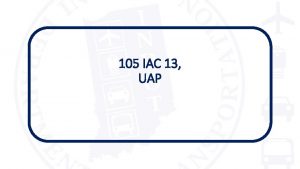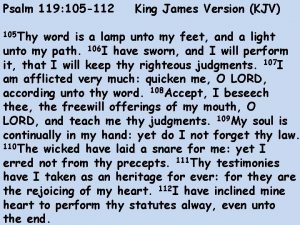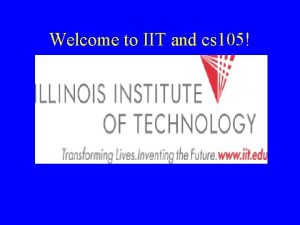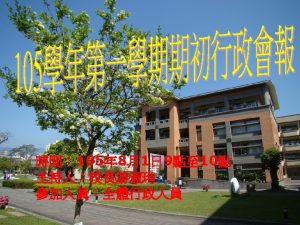CIS 105 Survey of Computer Information Systems Essential





































- Slides: 37

CIS 105 Survey of Computer Information Systems Essential Concepts and Terminology Study Unit 7 CIS 105 Concepts and Terminology Unit 7

Media Convergence. The unification of all earlier media forms (print, audio, video, animation, telephone) in a single medium. CIS 105 Concepts and Terminology Unit 7

Internet. The worldwide communication technology and infrastructure that links computer networks using TCP/IP protocol, enabling direct data exchange between any two connected computers. CIS 105 Concepts and Terminology Unit 7

ISP (Internet Service Provider). A company that provides Internet access, often by paid subscriptions, to businesses, organizations, and individuals. CIS 105 Concepts and Terminology Unit 7

Internet Protocol (IP). The rules enabling data to be sent from one computer to another on the Internet. The protocol specifies that each computer have at least one uniquely identifier, its IP address. CIS 105 Concepts and Terminology Unit 7

IP Address. The unique four-part number separated by periods (such as 216. 239. 120) used for identifying each computer connected to the Internet. CIS 105 Concepts and Terminology Unit 7

WWW (World Wide Web). The network of computer networks enabling connected users to access billions of pages of information. CIS 105 Concepts and Terminology Unit 7

Platform. A distinct class of computers, distinguished as using a specific type of processor and operating system. CIS 105 Concepts and Terminology Unit 7

Interoperability. The characteristic of the Internet that enables cross-platform computer operations. CIS 105 Concepts and Terminology Unit 7

Online Service. A proprietary network offering customized, fee-based access, client software, and services. CIS 105 Concepts and Terminology Unit 7

Portal. An Internet gateway providing organized content, often with free services to attract commercial activity and advertisers. CIS 105 Concepts and Terminology Unit 7

ARPANet. The network created in 1969 by the Advanced Research Projects Agency (ARPA). ARPANet was the first network to use the technology that is the basis of the Internet. CIS 105 Concepts and Terminology Unit 7

Client. A program running on a computer, such as a Web browser, that requests information from another computer. CIS 105 Concepts and Terminology Unit 7

Server. Any computer providing a service to other computers on a network. A program on a networked computer that provides data to client computers. CIS 105 Concepts and Terminology Unit 7

Hyperlink. Portion of a hypertext markup language document that directs a client program to retrieve another document. This technological advance enabled the World Wide Web. CIS 105 Concepts and Terminology Unit 7

Hypertext. Text strings in documents that are often underlined, highlighted, or otherwise emphasized to indicate their hyperlink property. CIS 105 Concepts and Terminology Unit 7

URL (Uniform Resource Locator). The unique address that specifies precisely the location of a Web page. CIS 105 Concepts and Terminology Unit 7

FTP (File Transfer Protocol). The set of rules enabling downloading and uploading of ASCII and text files via the Internet. CIS 105 Concepts and Terminology Unit 7

ASCII. Acronym for American Standard Code for Information Interchange, the predominant computer character set encoding, currently using 7 bit binary code to define 128 possible characters. CIS 105 Concepts and Terminology Unit 7

Executable File. A file containing instructions capable of running on a computer, usually with an. exe extension if intended for use on a PC. CIS 105 Concepts and Terminology Unit 7

Macro. Any set of instructions that automates a task. A macro can be written or created by performing a task while recording the steps. CIS 105 Concepts and Terminology Unit 7

Usenet. An Internet discussion group news service for collecting and storing information by topic categories, called newsgroups and forums. More than 50, 000 newsgroups exist. CIS 105 Concepts and Terminology Unit 7

Thread. A series of newsgroup articles with a continuing commentary on a particular subject. CIS 105 Concepts and Terminology Unit 7

Netiquette. Etiquette rules pertaining to use of Internet communications. CIS 105 Concepts and Terminology Unit 7

Flames. Angry or critical Internet communications. CIS 105 Concepts and Terminology Unit 7

Internet Chat Relay (ICR). Internet service that supports many channels of real-time, textbased conversation among multiple participants. CIS 105 Concepts and Terminology Unit 7

Transmission Control Protocol/Internet Protocol (TCP/IP). A standard set of communication rules used by every computer connected to the Internet. CIS 105 Concepts and Terminology Unit 7

Point-to-Point Protocol (PPP). A version of PCP/IP to connect a dial-up computer to the Internet using a temporarily assigned IP address. CIS 105 Concepts and Terminology Unit 7

Digital Subscriber Line (DSL). A protocol that enables highspeed, permanent online Internet connections using telephone lines. CIS 105 Concepts and Terminology Unit 7

Backbone. A transmission line that carries data gathered from smaller interconnected lines, at the local level, from LAN to LAN or from a LAN to a wide area network connection, or, on the Internet or other wide area network, a set of paths that local or regional networks connect to for long-distance interconnection. CIS 105 Concepts and Terminology Unit 7

Network Access Points (NAPS). Several major Internet interconnection points that provide major switching facilities and tie all the Internet access providers together. CIS 105 Concepts and Terminology Unit 7

Domain Name System (DNS). The system of Internet addressing that stores and translates meaningful and easy-to-remember text aliases (such as www. mc. maricopa. edu) into Internet Protocol addresses. CIS 105 Concepts and Terminology Unit 7

Internet Network Information Center (Inter. NIC). The organization originally responsible for registering and maintaining top-level domain names on the World Wide Web. Recently, competition was introduced and the Internet Corporation of Assigned Names and Numbers (ICANN) conducts registrar accreditation. CIS 105 Concepts and Terminology Unit 7

Top-Level Domain Names. gov Government agency. edu Educational institution. org Nonprofit organizations. com Commercial business. net Network organizations CIS 105 Concepts and Terminology Unit 7

Intranet. A local or wide-area computer network based in TCP/IP, and not necessarily available to external connections. CIS 105 Concepts and Terminology Unit 7

Firewall. A program to prevent or limit external access to a computer from networked connections. CIS 105 Concepts and Terminology Unit 7

End of Study Unit 7. � Return to first slide Move to Study Unit 8 CIS 105 Home Page CIS 105 Concepts and Terminology Unit 7 Created by James Q. Jacobs
 Clinical information system cis
Clinical information system cis Characteristics of lipids
Characteristics of lipids Acls abcd
Acls abcd The protection of information in computer systems
The protection of information in computer systems Types of printers
Types of printers Essential computer parts
Essential computer parts Identifying and non identifying adjective clauses
Identifying and non identifying adjective clauses Communication model
Communication model A survey of computer graphics
A survey of computer graphics Csi computer crime and security survey
Csi computer crime and security survey California health information survey
California health information survey Ugbs 105
Ugbs 105 Salmo 118:105
Salmo 118:105 12vac35-105-620
12vac35-105-620 Psalms 119:105 nlt
Psalms 119:105 nlt Psalm 105:1-3
Psalm 105:1-3 Prime numbers of
Prime numbers of 105 numerology
105 numerology Gst 105 use of english pdf
Gst 105 use of english pdf Contoh titrat
Contoh titrat Ge 105
Ge 105 Cos 120 exact value
Cos 120 exact value Fas 130
Fas 130 Exact value of sin 105°
Exact value of sin 105° 657 105. madde
657 105. madde Exact value of sin 105°
Exact value of sin 105° Psaume 119 signification
Psaume 119 signification 33 cfr 105
33 cfr 105 Salmo 105:1
Salmo 105:1 Eecs 105
Eecs 105 Eecs 105
Eecs 105 Eecs 105
Eecs 105 Cse 105 ucsd
Cse 105 ucsd Kcu 105
Kcu 105 105 m x 68 m
105 m x 68 m 4/6 simplified
4/6 simplified Cs 105 iit
Cs 105 iit Jon hanrath
Jon hanrath



